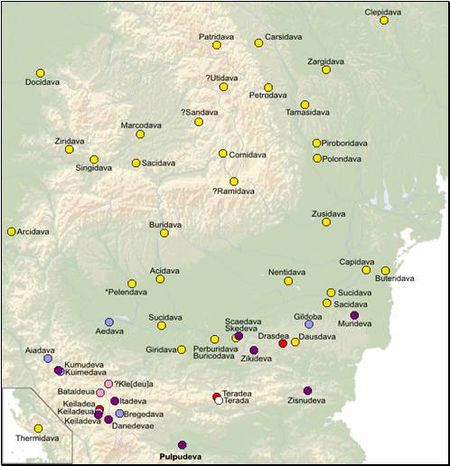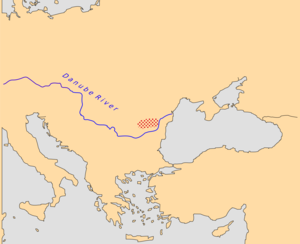گتاي

گتاي أو گتي (باللاتينية: getae ؛ وباليونانية: Γέται، ومفردها Γέτης ؛ بالروسية : Геты ، بالبلغارية: Гети ) هم شعوب محاربة تراقية/داتشية استوطنت أسفل الدانوب (فيما هو الآن شمال بلغاريا ورومانيا) في عام 339 ق.م.. وكان ذلك خلف المستعمرات اليونانية على ساحل البحر الأسود.
يقول عنهم المؤرخ الإغريقي هيرودوت: " الگتيون هم الأكثر رجولة والأكثر تجرداً وإنصافاً بين التراقيين ". وذللك في كتابه عن حملة داريوس الأول أو داريوش الأول على السكوذيين في عام 513 ق.م.. فقد تحدى الجتيون سلطة الحاكم الفارسي ولكنه هزمهم كما هزم باقي القبائل التراقية على الضفة اليمنى لنهر الدانوب. ويقول هرودوت أن الگتاي كانوا يختلفون عن باقي القبائل التراقية في الديانة، فقد كانوا يعبدون الإله زلموخيس الذي كان بعض الگتاي يسمونه گبليزيس.[1]
بعد التخلص من الحكم الفارسي أصبح الجتاي علي يمين نهر الدانوب جزءاً من المملكة الاودريسية Odrysian kingdom حتى أخضعهم فيليب الثاني لحكم المقدونيين في عام 340 ق.م.
دفع احتلال مناطق الغيتين جنوب النهر من طموحات المقدونيين للسيطرة على مناطق الگتائيين في شمال النهر إلى الأمام ، لكن محاولات الإسكندر المقدوني المتوالية في العام 327 ق.م. والعام 335 ق.م. باءت جميعاً بالفشل. إلا أن هزمهم وأخضعهم ومحى من الوجود أحد مستوطناتهم قبل أن يبدأ في حملته الفارسية.[2] وفي عام 313 ق.م. تحالف الگتاي مع كلاتس واودسوس ومستعمرات يونانية پونطية غربية أخرى ضد ليزيماخوس Lysimachus، الذي كان يحتفظ بحصن في تريزس (كالياكرا الحالية).[3]
الگتاي والداتشا
المصادر القديمة

التفسيرات الحديثة
نفس الشعب

الذكرى
على مدى التاريخ ، خلط بعض المؤرخين ما بين الگتاي والقوط وهي قبائل جرمانية شرقية.
انظر أيضاً
الهامش
- ^ Herodotus. Histories, 4.93-4.97.
- ^ Arrian. Anabasis, Book IA. "The Getae did not sustain even the first charge of the cavalry; for Alexander’s audacity seemed incredible to them, in having thus easily crossed the Ister, the largest of rivers, in a single night, without throwing a bridge over the stream. Terrible to them also was the closely-locked order of the phalanx, and violent the charge of the cavalry. At first they fled for refuge into their city, which. was distant about a parasang from the Ister; but when they saw that Alexander was leading his phalanx carefully along the side of the river, to prevent his infantry being anywhere surrounded by the Getae lying in ambush, but that he was sending his cavalry straight on, they again abandoned the city, because it was badly fortified."
- ^ Strabo. Geography, 7.6.1. "On this coast-line is Cape Tirizis, a stronghold, which Lysimachus once used as a treasury."
المراجع
القديمة
- Appian (c. 160 AD). Historia Romana [Roman History] (in Ancient Greek).
{{cite book}}: Check date values in:|year=(help)CS1 maint: unrecognized language (link) - Justin (c. 3rd century AD). Trogi pompei historiarum philippicarvm epitoma [Epitome of the Philippic History of Pompeius Trogus] (in Latin).
{{cite book}}: Check date values in:|year=(help)CS1 maint: unrecognized language (link) - Pliny the Elder (77-79 AD). Naturalis Historia [Natural History] (in Latin).
{{cite book}}: Check date values in:|year=(help)CS1 maint: unrecognized language (link) - Strabo (c. 20 AD). Geographica (in Ancient Greek).
{{cite book}}: Check date values in:|year=(help)CS1 maint: unrecognized language (link)
الحديثة
- Avery, Catherine B. (1962). The New Century classical handbook. Appleton-Century-Crofts.
{{cite book}}: Invalid|ref=harv(help) - Bunbury, Edward Herbert (1979). A history of ancient geography among the Greeks and Romans: from the earliest ages till the fall of the Roman empire. London: Humanities Press International, Incorporated. ISBN 978-90-70265-11-3.
{{cite book}}: Invalid|ref=harv(help) - Fol, Alexander (1996). "Thracians, Celts, Illyrians and Dacians". History of Humanity: From the seventh century B.C. to the seventh century A.D. edited by Unesco. Bernan Assoc; illustrated edition. ISBN 978-92-3-102812-0.
{{cite book}}: Invalid|ref=harv(help) - Millar, Fergus; Cotton, Hannah M.; Rogers, Guy M. (2004). Rome, the Greek World, and the East, Volume 2: Government, Society, and Culture in the Roman Empire. University of North Carolina Press. ISBN 978-0-8078-5520-1.
{{cite book}}: Invalid|ref=harv(help) - Matyszak, Philip (2009). The Enemies Of Rome. Thames and Hudson. ISBN 978-0-500-28772-9.
{{cite book}}: Invalid|ref=harv(help) - Minahan, James B. (2000). One Europe, Many Nations: A Historical Dictionary of European National Groups. Greenwood Publishing Group. ISBN 978-0313309847.
{{cite book}}: Invalid|ref=harv(help) - Sandler Berkowitz, David; Morison, Richard (1984). Humanist Scholarship and Public Order: Two Tracts Against the Pilgrimage of Grace. Associated Univ Pr. ISBN 978-0918016010.
{{cite book}}: Invalid|ref=harv(help) - Sidebottom, Harry (2007). "International Relations". The Cambridge History of Greek and Roman Warfare: Volume 2, Rome from the Late Republic to the Late Empire. Cambridge University Press. ISBN 978-0-521-78274-6.
{{cite book}}: Invalid|ref=harv(help) - Waldman, Carl; Mason, Catherine (2006). Encyclopedia of European Peoples. Thames and Hudson. ISBN 978-0-8160-4964-6.
{{cite book}}: Invalid|ref=harv(help)

